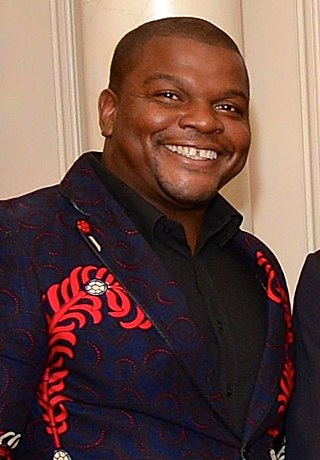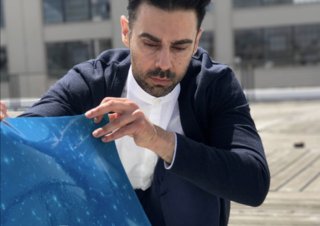Related Research Articles
Edward Joseph Ruscha IV is an American artist associated with the pop art movement. He has worked in the media of painting, printmaking, drawing, photography, and film. He is also noted for creating several artist's books. Ruscha lives and works in Culver City, California.

Kehinde Wiley is an American portrait painter based in New York City known for his naturalistic paintings of Black people that reference the work of Old Master paintings. In 2017, Wiley was commissioned to paint former President Barack Obama's portrait for the Smithsonian National Portrait Gallery. The Columbus Museum of Art hosted an exhibition of his work in 2007 and describes his paintings as "heroic portraits which address the image and status of young African-American men in contemporary culture."

Gronk, born Glugio Nicandro, is a Chicano painter, printmaker, and performance artist. His work is collected by museums around the country including the Smithsonian American Art Museum.
Judy Jensen is an American artist who resides in Austin, Texas. She is best known for her reverse painting on glass, although she incorporates other mixed media into her glass pieces. According to Nancy Bless, Jensen's works "lie somewhere between a collage and a collection."

Sadegh Tirafkan was an Iranian contemporary artist who lived mainly in Tehran, Iran.
Kerry James Marshall is an American artist and professor, known for his paintings of Black figures. He previously taught painting at the School of Art and Design at the University of Illinois at Chicago. In 2017, Marshall was included on the annual Time 100 list of the most influential people in the world. He was born and raised in Birmingham, Alabama, and moved in childhood to South Central Los Angeles. He has spent much of his career in Chicago, Illinois.

Barkley L. Hendricks was a contemporary American painter who made pioneering contributions to Black portraiture and conceptualism. While he worked in a variety of media and genres throughout his career, Hendricks' best known work took the form of life-sized painted oil portraits of Black Americans.

Christopher Myers is an American interdisciplinary artist, author and illustrator of children's books, and playwright. His wide-ranging practice—including tapestries, sculpture, stained glass lightboxes, theater and writing—is rooted in storytelling and artmaking as modes of transformation and cultural exchange. He explores contemporary hybrid cultures and identities resulting from histories of migration, globalization and colonization. Critics have noted his work's fluid movement between disciplines, image and language, sociopolitical research and mythology, and diverse materials. Shana Nys Dambrot of LA Weekly wrote, "Ideas about authorship, collaboration, cross-cultural pollination, intergenerational storytelling, mythology, literature and the oral histories of displaced communities all converge in his literal and metaphorical patchwork tableaux … [his] sharp, emotional and sometimes dark parables express it all in bright, jubilant patterns and saturated colors."

Ala Ebtekar is a contemporary artist known primarily for his work in painting, drawing, illumination, and installation. His work frequently orchestrates various orbits and cadences of time, bringing forth sculptural and photographic possibilities of the universe, and time, gazing back at us.

Candida Alvarez is an American artist and professor, known for her paintings and drawings.

Shulamit Nazarian is a contemporary art gallery located in Los Angeles, California.

Henry Taylor is an American artist and painter who lives and works in Los Angeles, California. He is best known for his acrylic paintings, mixed media sculptures, and installations.
Keyvan Heydari-Shovir, also known as CK1, is an Iranian-born contemporary artist, and street artist. His work combines Iranian traditional culture with contemporary pop culture, and he is a pioneer of Iranian graffiti art. He lives in Los Angeles, and previously lived in San Francisco and Tehran.
Vincent Valdez is an American artist born in San Antonio, Texas, who focuses on painting, drawing, and printmaking. His artwork often emphasizes themes of social justice, memory, and ignored or under-examined historical narratives. Valdez completed his B.F.A. at the Rhode Island School of Design in 2000. He lives and works in Houston, Texas, and is represented by the David Shelton Gallery (Houston) and Matthew Brown Gallery. Valdez's work has been exhibited at Museum of Fine Arts, Houston, Ford Foundation, Los Angeles County Museum of Art, National Portrait Gallery, Blanton Museum of Art, Parsons School of Design, and the Fundacion Osde Buenos Aires.

Harmonia Rosales is an American artist from Chicago.
Jeff Sonhouse is an African American painter, known for his mixed media portraiture dealing with Black identity.
Marion Sampler was an American designer. Sampler was most known for being one of the first Black graphic designers to work in commercial design firms.
WangShui (1986) is an American contemporary artist. They work across a range of media including film, installation, painting, and sculpture. They are based in New York City.

Joe Ray is an American artist based in Los Angeles. His work has moved between abstraction and representation and mediums including painting, sculpture, performance art and photography. He began his career in the early 1960s and belonged to several notable art communities in Los Angeles, including the Light and Space movement; early cast-resin sculptors, including Larry Bell; and the influential 1970s African-American collective, Studio Z, of which he was a founding member with artists such as David Hammons, Senga Nengudi and Houston Conwill. Critic Catherine Wagley described Ray as "an artist far more committed to understanding all kinds of light and space than to any specific material or strategy"—a tendency that she and others have suggested led to his being under-recognized.
Bony Ramirez is a Dominican-born American self-taught painter and visual artist based in Perth Amboy, New Jersey and Harlem, New York. Ramirez works primarily in paintings, sculptures, and installations that comment on elements of Caribbean visual and material culture.
References
- ↑ Keshmirshekan, Hamid; Irving, Mark; Downey, Anthony (2009). Different Sames: New Perspectives in Contemporary Iranian Art. Thames & Hudson. p. 124. ISBN 978-0-500-97697-5.
- ↑ Dambrot, Shana Nys (September 25, 2017). "Amir H. Fallah presents his first solo exhibition, "A STRANGER in Your Home": His Art and Our Thoughts". Flaunt Magazine. Retrieved 2020-10-31.
- ↑ "Amir H. Fallah: No Gods, No Masters". LA Weekly. 2020-10-01. Retrieved 2020-10-31.
- ↑ Gerwin, Daniel. "Amir H. Fallah at Shulamit Nazarian". Artforum.com. Retrieved 2020-10-31.
- ↑ "5 Not-to-Be-Missed Los Angeles Solo Shows". Art & Object. Retrieved 2020-10-31.
- 1 2 3 Al Hadethi, Rand (April 7, 2020). "Iranian-Born Artist Amir H. Fallah Creates Work That Thrives In A Cultural Limbo". GQ Middle East.
- ↑ "Amir H. Fallah". New American Paintings. Retrieved 2020-10-31.
- ↑ "Human Condition: Limbo in an Abandoned Hospital". Art21 Magazine. Retrieved 2020-10-31.
- ↑ "EXPO CHGO ONLINE: Six Artwork Highlights". ocula.com. 2022-10-28. Retrieved 2022-10-28.
- ↑ Liou, Caroline Ellen (2020-10-14). "How Do You Paint Portraiture Without a Portrait?". Hyperallergic. Retrieved 2022-10-28.
- ↑ Scott, Chadd. "Amir H. Fallah, Painting For An Audience Of One With Lessons For A Lifetime". Forbes. Retrieved 2022-10-28.
- ↑ "Art Mamas: Amir H. Fallah Paints a Roadmap for His Son". Whitewall. Retrieved 2022-11-23.
- ↑ Liou, Caroline Ellen (2020-10-14). "How Do You Paint Portraiture Without a Portrait?". Hyperallergic. Retrieved 2022-11-23.
- ↑ "Amir H. Fallah Created Stained Glass "Portals" for the LA County Department of Mental Health". HYPEBEAST. 2021-08-30. Retrieved 2022-10-28.